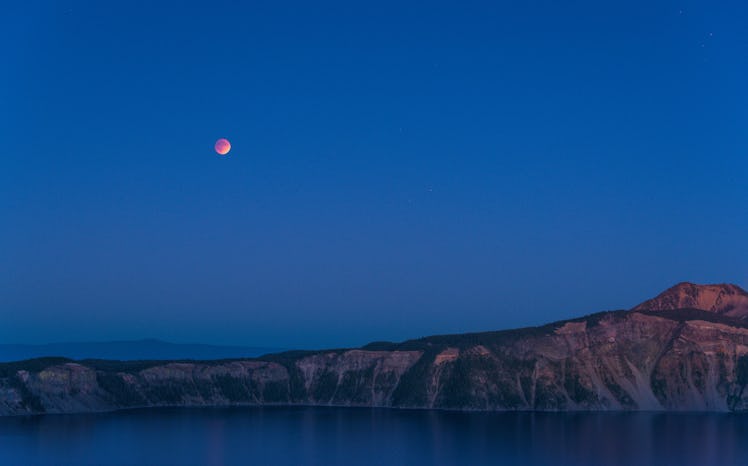Feeling blue? Maybe the Sunday scaries are already lurking, or the wintertime blues are just starting to hit home a bit. We're starting to miss summer and sunshine too, and vacations in tropical places have never been so needed. But, where the sun is taking somewhat of a break right now, the moon is making up for it with shows in the sky we just can't bear to miss. We started off the year strong, coming into 2018 with new resolutions and a supermoon in the sky. On New Year's Day, we saw the second in a three-part series of full moons that began in early December and will end with one more lovely lunar light show on the Jan. 31. So, what is a super blue blood moon? Let's study up a bit, shall we?
Remember the Wolf Moon? The galaxy threw one last party with a moon so big that it was worth popping an extra bottle of champagne. Sure, anytime there's a full moon life feels a little spooky -- especially when it falls on New Year's Day. Like Mercury Retrograde, our day-to-day lives can often seem rooted in extremes or miscommunications when the moon decides to show off -- or moon us, if you will. But it was a pretty rad way to ring in the New Year, nonetheless.
The Super Blue Blood Moon will be a bit similar to the Wolf Moon, but with even more glitz and glam from the galaxy. The best way to understand what is going to go down that night is to break it down into sections. Science can be so tricky, and if you're going to walk the moonwalk, you're going to need to talk the, well, moon talk.
What is a supermoon?
A supermoon is what naturally occurs when the moon is closer to Earth in its orbit. The orbit of the moon is shaped something like an oval. Throughout the month it rotates around this path, going through the various phases along the way.
When the moon is in this "super" state, it looks a lot brighter and larger. Although its actual size does not change at all, the moon will appear to be about 14 percent larger and 30 percent more luminous, according to NASA. The sun might have some serious competition in our favorite nighttime friend.
What is a Blood Moon?
A Blood Moon is another way of saying the moon is going through a total lunar eclipse. Look at it this way, the moon is getting a bit of a makeover for a moment.
A total lunar eclipse happens when the moon falls in the Earth's shadow. It's completely blocked by the sun's spotlight, so instead of showing up bright white like it would on a usual night, the moon will carry a spectrum of a sunset. This happens because, although all the sunlight is being blocked by our lovely planet, the atmosphere sends some saturated color onto the surface of the moon. All in all, you can expect the circle in the sky to look like cheddar instead of a creamy slice of American cheese.
What is a Blue Moon?
Blue Moons don't come around all the time, so you'll want to sneak a peek at the sky for this somewhat rare phenomena. According to Space.com, they occur pretty much once every 2.7 years. Where do you think that phrase "once in a Blue Moon" came from?
Contrary to what we would believe, the moon doesn't actually turn blue. A "Blue Moon" is just another fancy term for a second full moon during a month-long time span. Since certain parts of the world won't experience the full moon until the first day of February, they won't technically see a Blue Moon. But, it will be big and bright just the same. Are you staying with me?
What is a Super Blue Blood Moon?
So, now let's combine all of what we just learned. Don't worry there's no quiz at the end of this article. But, hopefully you'll feel a little more educated about the Earth and all its friends in space.
On Jan. 31, the Super Blue Blood Moon will basically be the second full moon of the season, in super form, and with the color of a sunset. Grab your cameras, because you won't want to sleep or space out on this sight.
